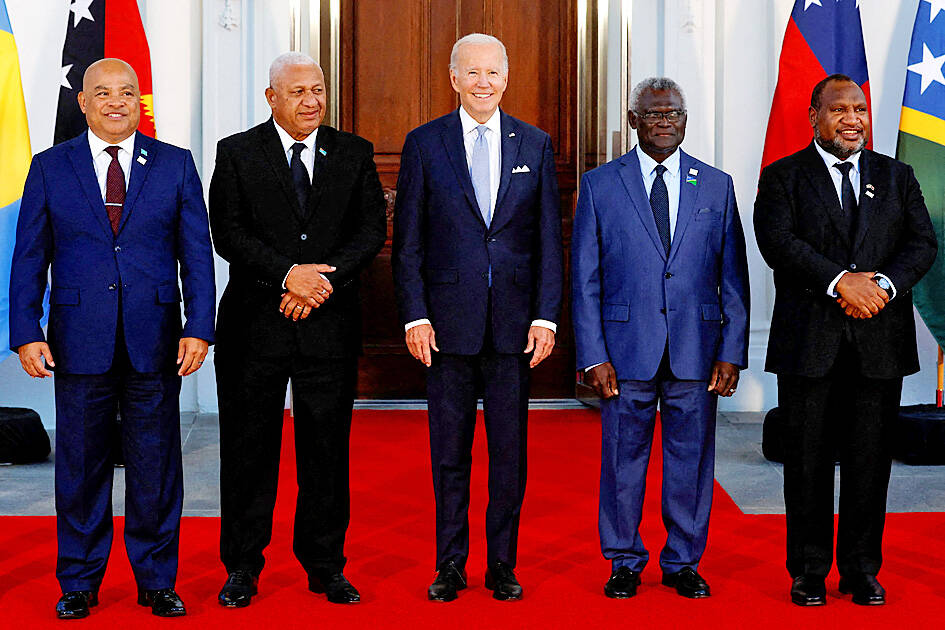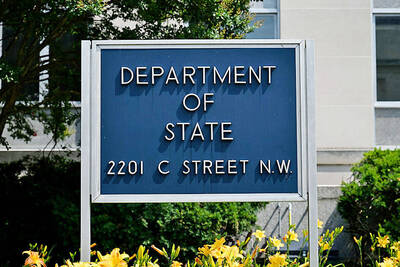Papua New Guinea (PNG) said it would sign a defense agreement with the US, ahead of a deal with Australia and despite opposition party concerns that it could upset China, because the Ukraine conflict shows the need for military capability.
Today, the Pacific island nation is to host visits by US Secretary of State Antony Blinken, Indian Prime Minister Narendra Modi, New Zealand Prime Minister Chris Hipkins and other Pacific island leaders.
While Modi’s visit is expected to focus on trade, Blinken is to sign a defense cooperation agreement (DCA) with PNG Prime Minister James Marape, the two nations have said.

Photo: Reuters
The agreement would boost PNG’s defense infrastructure and capability after decades of neglect, a government statement said on Saturday.
Highlighting domestic political sensitivity over taking sides in strategic competition between the US and China, the statement said the deal would “not stop Papua New Guinea from working with other nations including China.”
The defense agreement would also not give visiting US military personnel immunity for criminal conduct, the statement said.
“Assets developed under DCA will be owned by PNG Government,” it added.
The DCA is about building defense capabilities because border disputes are “inevitable in the future,” it said.
“Papua New Guinea does not have enemies, but it pays to be prepared,” it said, citing Russia’s invasion of Ukraine.
China, a major infrastructure provider to the Pacific islands, has sought to increase its security role, signing a security pact with the Solomon Islands that prompted criticism from the US and its allies about Beijing’s intentions.
While in PNG, Blinken and Palauan President Surangel Whipps Jr are today to sign a strategic agreement, before the US state secretary heads to Micronesia to sign a similar deal tomorrow, US Special Presidential Envoy for Compact Negotiations Joseph Yun said.
Yun said he hopes to conclude a deal with the Marshall Islands soon.
“We have made progress over my three-day visit to Marshall Islands and we hope to sign an agreement with the Marshall Islands in the coming weeks,” he said.
Washington reached what are known as Compact of Free Association (COFA) accords with the three island states in the 1980s, under which it retains responsibility for their defense and provides economic assistance while gaining exclusive access to huge strategic swathes of the Pacific in return.
Renewing them has become a key part of US efforts to push back against China’s bid to expand its influence in the region. Chinese diplomats have been courting the region and China’s construction and mining companies have expanded their business in many Pacific island nations.
The Marshall Islands’ COFA is due to expire this year. Yun gave no reason for the holdup in renewing it, but a parliamentary election is expected there in November.
Yun called the deals “strategically important.”
“We’ve achieved two out of three,” he said. “Compacts are very important for the United States. It defines the relationship between us and northern half of the Pacific.”

A car bomb killed a senior Russian general in southern Moscow yesterday morning, the latest high-profile army figure to be blown up in a blast that came just hours after Russian and Ukrainian delegates held separate talks in Miami on a plan to end the war. Kyiv has not commented on the incident, but Russian investigators said they were probing whether the blast was “linked” to “Ukrainian special forces.” The attack was similar to other assassinations of generals and pro-war figures that have either been claimed, or are widely believed to have been orchestrated, by Ukraine. Russian Lieutenant General Fanil Sarvarov, 56, head

SAFETY FIRST: Double the number of police were deployed at the Taipei Marathon, while other cities released plans to bolster public event safety Authorities across Taiwan have stepped up security measures ahead of Christmas and New Year events, following a knife and smoke bomb attack in Taipei on Friday that left four people dead and 11 injured. In a bid to prevent potential copycat incidents, police deployments have been expanded for large gatherings, transport hubs, and other crowded public spaces, according to official statements from police and city authorities. Taipei Mayor Chiang Wan-an (蔣萬安) said the city has “comprehensively raised security readiness” in crowded areas, increased police deployments with armed officers, and intensified patrols during weekends and nighttime hours. For large-scale events, security checkpoints and explosives

PUBLIC SAFETY: The premier said that security would be tightened in transport hubs, while President Lai commended the public for their bravery The government is to deploy more police, including rapid response units, in crowded public areas to ensure a swift response to any threats, President William Lai (賴清德) said yesterday after a knife attack killed three people and injured 11 in Taipei the previous day. Lai made the remarks following a briefing by the National Police Agency on the progress of the investigation, saying that the attack underscored the importance of cooperation in public security between the central and local governments. The attack unfolded in the early evening on Friday around Taipei Main Station’s M7 exit and later near the Taipei MRT’s Zhongshan

REBUFFED: In response to Chinese criticism over recent arms sales, Washington urged Beijing to engage in meaningful dialogue instead of threats and intimidation Washington’s long-term commitment to Taiwan would not change, the US Department of State said yesterday, urging Beijing to stop pressuring Taiwan and engage in meaningful bilateral dialogues. The remarks came in response to a backlash from Beijing about Washington’s latest approval of arms sales to Taiwan. The US Defense Security Cooperation Agency said in a statement on Wednesday that the Taipei Economic and Cultural Representative Office in the US has asked to purchase an arms package, including Tactical Mission Network Software; AH-1W helicopter spare and repair parts; M109A7 self-propelled howitzers; HIMARS long range precision strike systems; tube-launched, optically tracked, wire-guided missiles; Javelin